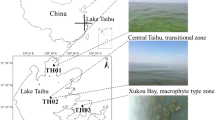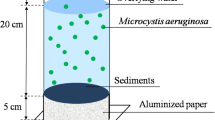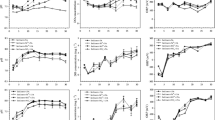Abstract
Direct evidence of the algae bloom in eutrophic freshwater lakes on sulfur cycle and the subsequent iron oxide reduction and the iron oxides-bound phosphate (Fe–P) release in sediments is lacking. In this study, microcosms experiment was carried out to investigate the dynamic variations of S, Fe and P species in the water column and sediments as well as the sulfate reducing bacteria (SRB) abundance variation in the sediments during algae decomposition. The sulfate reduction was stimulated by the algae decomposition, which resulted in dramatic sulfate decline, sulfide increase and SRB growth. In addition, large amounts of acid volatile sulfide (AVS), pyrite sulfur (Pyrite–S) and elemental sulfur (S0) accumulated in the sediment. In particular, the contents of sedimentary Fe(II) and Pyrite–S in surface sediments continuously accumulated until the end of the experiment. Moreover, the terminal Fe–P content reduced by 35.4% compared with the initial concentration at high algae density group. These results suggested the irreversible reduction of iron oxides and revealed iron chemical reduction mediated by sulfide during algae decomposition. In addition, the connection of sulfur–iron cycle and the significant promotion of Fe–P mobilization in sediments was established, which should be paid more attention in the eutrophic freshwater ecosystems.






Similar content being viewed by others
References
Amirbahman A, Pearce AR, Bouchard RJ, Norton SA, Kahl JS (2003) Relationship between hypolimnetic phosphorus and iron release from eleven lakes in Maine, USA. Biogeochemistry 65:369–385
Capone DG, Kiene RP (1988) Comparison of microbial dynamics in marine and freshwater sediments: contrasts in anaerobic carbon catabolism. Limnol Oceanogr 33:725–749
Chen M, Li XH, He YH, Song N, Cai HY, Wang CH, Li YT, Chu HY, Krumholz LR, Jiang HL (2016) Increasing sulfate concentrations result in higher sulfide production and phosphorous mobilization in a shallow eutrophic freshwater lake. Water Res 96:94–104
Chen MS, Ding SM, Chen X, Sun Q, Fan XF, Lin J, Ren MY, Yang LY, Zhang CS (2018) Mechanisms driving phosphorus release during algal blooms based on hourly changes in iron and phosphorus concentrations in sediments. Water Res 133:153–164
Chen Q, Chen JG, Wang JF, Guo JY, Jin ZX, Yu PP, Ma ZZ (2019) In situ, high-resolution evidence of phosphorus release from sediments controlled by the reductive dissolution of iron-bound phosphorus in a deep reservoir, southwestern China. Sci Total Environ 666:39–45
Cline JD (1969) Spectrophotometric determination of hydrogen sulfide in natural waters. Limnol Oceanogr 14:454–458
Didar-Ul-Alam M (2003) Decomposition rate and nutrient release by blue-green algae in Bangladesh soil. Bangladesh J Bot 32:101–106
Ding SM, Wang Y, Li YY, Gong MD, Zhang CS(2016) In situ, high resolution evidence for iron coupled mobilization of phosphorus in sediments. Sci Rep 6:24341
Fedorov YA, Mikhailenko AV, Dotsenko IV (2019) Sulfide sulfur in water objects with different mineralization. Water Resour 46:S59–S64
Feng ZY, Fan CX, Huang WY, Ding SM (2014) Microorganisms and typical organic matter responsible for lacustrine “black bloom”. Sci Total Environ 470–471:1–8
Friedrich MW, Finster KW (2014) How sulfur beats iron. Science 344:974–975
Foti M, Sorokin DY, Lomans B, Mussman M, Zacharova EE, Muyzer G (2007) Diversity, activity, and abundance of sulfate-reducing bacteria in saline and hypersaline soda lakes. Appl Environ Microbiol 73(7):2093–2100
Hall KC, Baldwin DS, Rees GN, Richardson AJ (2006) Distribution of inland wetlands with sulfidic sediments in the Murray-Darling Basin, Australia. Sci Total Environ 370:235–244
Han C, Ding SM, Yao L, Shen QS, Zhu CG, Wang Y, Xu D (2015) Dynamics of phosphorus-iron-sulfur at the sediment-water interface influenced by algae blooms decomposition. J Hazard Mater 300:329–337
Hansel CM, Lentini CJ, Tang YZ, Johnston DT, Wankel SD, Jardine PM (2015) Dominance of sulfur-fueled iron oxide reduction in low-sulfate freshwater sediments. ISME J 9:2400–2412
Ho JC, Michalak AM, Pahlevan N (2019) Widespread global increase in intense lake phytoplankton blooms since the 1980s. Nature 574:667–670
Holmer M, Storkholm P (2001) Sulphate reduction and sulphur cycling in lake sediments: a review. Freshw Biol 46:431–451
Holmkvist L, Ferdelman TG, Jorgensen BB (2011) A cryptic sulfur cycle driven by iron in the methane zone of marine sediment (Aarhus Bay, Denmark). Geochimica Et Cosmochimica Acta 75:3581–3599
Hsieh Y, Shieh Y (1997) Analysis of reduced inorganic sulfur by diffusion methods: improved apparatus and evaluation for sulfur isotopic studies. Chem Geol 137:255–261
James RT, McCormick PV (2012) The sulfate budget of a shallow subtropical lake. Fundam Appl Limnol 181:253–269
Lehtoranta J, Ekholm P, Pitkanen H (2009) Coastal eutrophication thresholds: a matter of sediment microbial processes. Ambio 38:303–308
Liu ZS, Zhang Y, Han F, Yan P, Liu BY, Zhou QH, Min FL, He F, Wu ZB (2018) Investigation on the adsorption of phosphorus in all fractions from sediment by modified maifanite. Sci Rep 8. https://doi.org/10.1038/s41598-018-34144-w
Loh PS, Ying CY, Alnoor HIM, Huang XR, Lou ZH, Chen XG, He SY, Jiang ZP, Jin AM (2020) Comparative study on the elucidation of sedimentary phosphorus species using two methods, the SMT and SEDEX methods. J Anal Methods Chem 2020. https://doi.org/10.1155/2020/8548126
Lovley DR, Phillips EJ (1988) Novel mode of microbial energy metabolism: organic carbon oxidation coupled to dissimilatory reduction of iron or manganese. Appl Environ Microbiol 54:1472–1480
Luo GZ, Xu GM, Tan HX, Gao JF, Liu WC (2016) Effect of dissolved oxygen on denitrification using polycaprolactone as both the organic carbon source and the biofilm carrier. Int Biodeterior Biodegrad 110:155–162
Moosmann L, Gachter R, Muller B, Wuest A (2006) Is phosphorus retention in autochthonous lake sediments controlled by oxygen or phosphorus? Limnol Oceanogr 51:763–771
Mort HP, Slomp CP, Gustafsson BG, Andersen TJ (2010) Phosphorus recycling and burial in Baltic Sea sediments with contrasting redox conditions. Geochimica et Cosmochimica Acta 74:1350–1362
Ni ZK, Wang SR, Wu Y, Pu J (2020) Response of phosphorus fractionation in lake sediments to anthropogenic activities in China. Sci Total Environ 699:134242
Poulton SW (2003) Sulfide oxidation and iron dissolution kinetics during the reaction of dissolved sulfide with ferrihydrite. Chem Geol 202:79–94
Qin BQ, Xu PZ, Wu QL, Luo LC, Zhang YL (2007) Environmental issues of Lake Taihu, China. Hydrobiologia 581:3–14
Raiswell R, Berner RA (1986) Pyrite and organic matter in Phanerozoic normal marine shales. Geochimica et Cosmochimica Acta 50:1967–1976
Rickard D, Luther III GW (2007) Chemistry of iron sulfides. Chem Rev 107:514–562
Roden EE, Edmonds JW (1997) Phosphate mobilization in iron-rich anaerobic sediments: microbial Fe (III) oxide reduction versus iron-sulfide formation. Archiv für Hydrobiologie 139:347–378
Sulu-Gambari F, Seitaj D, Meysman FJ, Schauer R, Polerecky L, Slomp CP (2016) Cable bacteria control iron-phosphorus dynamics in sediments of a coastal hypoxic basin. Environ Sci Technol 50:1227–1233
Tabatabai M (1974) A rapid method for determination of sulfate in water samples. Environ Lett 7:237–243
Taylor KG, Konhauser KO (2011) Iron in earth surface systems: a major player in chemical and biological processes. Elements 7:83–88
Weber KA, Achenbach LA, Coates JD (2006) Microorganisms pumping iron: anaerobic microbial iron oxidation and reduction. Nat Rev Microbiol 4:752–764
Wu SJ, Zhao YP, Chen YY, Dong XM, Wang MY, Wang GX (2019) Sulfur cycling in freshwater sediments: a cryptic driving force of iron deposition and phosphorus mobilization. Sci Total Environ 657:1294–1303
Xu L, Zhuang GC, Montgomery A, Liang QY, Joye SB, Wang FP (2020) Methyl-compounds driven benthic carbon cycling in the sulfate-reducing sediments of South China Sea. Environ Microbiol. https://doi.org/10.1111/1462-2920.15110
Zhao YP, Zhang ZQ, Wang GX, Li XJ, Ma J, Chen S, Deng H, Annalisa OH (2019) High sulfide production induced by algae decomposition and its potential stimulation to phosphorus mobility in sediment. Sci Total Environ 650:163–172
Acknowledgements
This work was supported by the National Natural Science Foundation of China (No. 41573061, 21407076), the Natural Science Foundation of the Higher Education Institutions of Jiangsu Province, China (No. 18KJB610011), and the Major Science and Technology Program for Water Pollution Control and Treatment (No. 2017ZX07203-003).
Author information
Authors and Affiliations
Contributions
SZ is the main participant of the experiment and wrote the article. YZ is the corresponding author and the co-first author of the article responsible for the research ideas, the design of the research program, the overall implementation of the experiment, and the revision of the article. CZ and HD undertook the construction of experimental systems and the testing of samples. GW mainly participated in the discussion of the experimental results and applied helpful suggestions during the writing of the article.
Corresponding authors
Ethics declarations
Conflict of interest
The authors declare that they have no conflict of interest.
Additional information
Publisher’s note Springer Nature remains neutral with regard to jurisdictional claims in published maps and institutional affiliations.
Supplementary information
Rights and permissions
About this article
Cite this article
Zhang, S., Zhao, Y., Zhou, C. et al. Dynamic sulfur–iron cycle promoted phosphorus mobilization in sediments driven by the algae decomposition. Ecotoxicology 30, 1662–1671 (2021). https://doi.org/10.1007/s10646-020-02316-y
Accepted:
Published:
Issue Date:
DOI: https://doi.org/10.1007/s10646-020-02316-y




